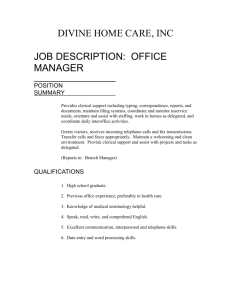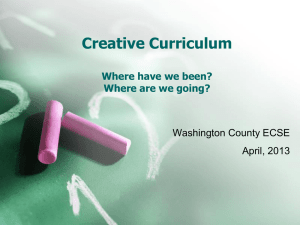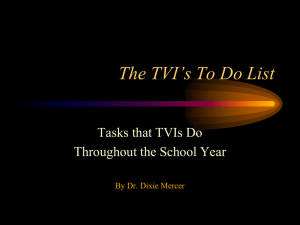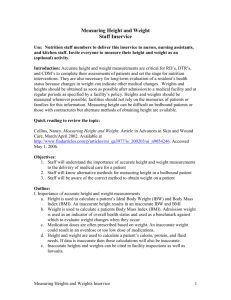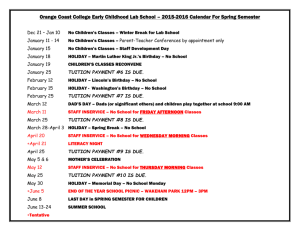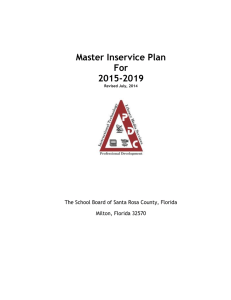Inservices requirement
advertisement
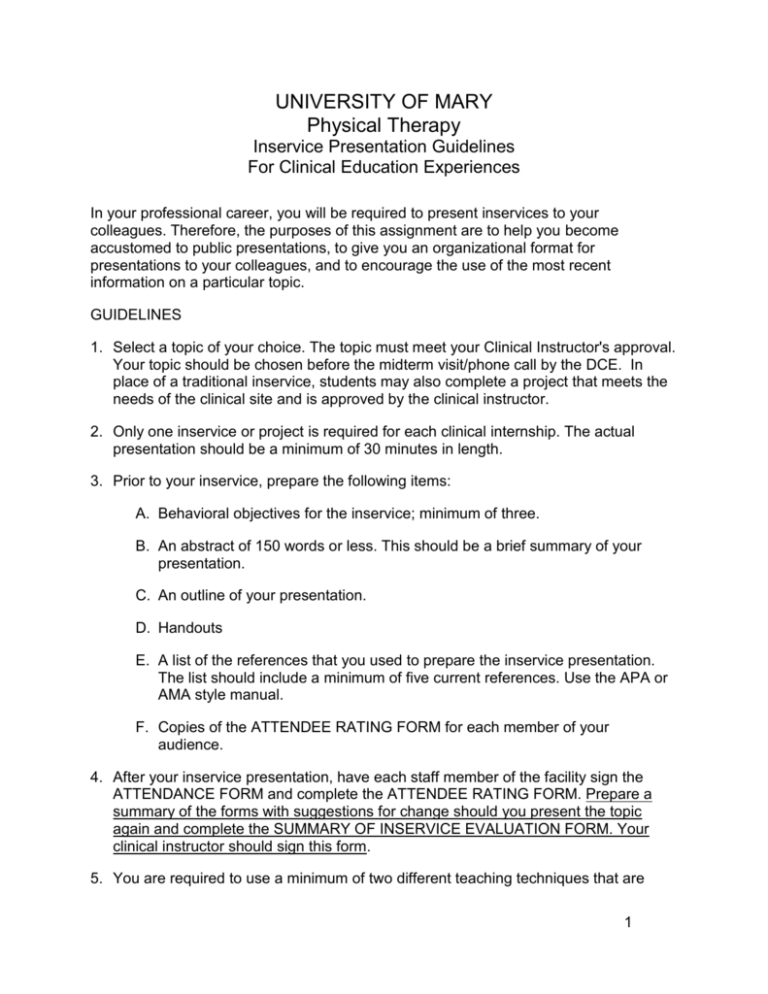
UNIVERSITY OF MARY Physical Therapy Inservice Presentation Guidelines For Clinical Education Experiences In your professional career, you will be required to present inservices to your colleagues. Therefore, the purposes of this assignment are to help you become accustomed to public presentations, to give you an organizational format for presentations to your colleagues, and to encourage the use of the most recent information on a particular topic. GUIDELINES 1. Select a topic of your choice. The topic must meet your Clinical Instructor's approval. Your topic should be chosen before the midterm visit/phone call by the DCE. In place of a traditional inservice, students may also complete a project that meets the needs of the clinical site and is approved by the clinical instructor. 2. Only one inservice or project is required for each clinical internship. The actual presentation should be a minimum of 30 minutes in length. 3. Prior to your inservice, prepare the following items: A. Behavioral objectives for the inservice; minimum of three. B. An abstract of 150 words or less. This should be a brief summary of your presentation. C. An outline of your presentation. D. Handouts E. A list of the references that you used to prepare the inservice presentation. The list should include a minimum of five current references. Use the APA or AMA style manual. F. Copies of the ATTENDEE RATING FORM for each member of your audience. 4. After your inservice presentation, have each staff member of the facility sign the ATTENDANCE FORM and complete the ATTENDEE RATING FORM. Prepare a summary of the forms with suggestions for change should you present the topic again and complete the SUMMARY OF INSERVICE EVALUATION FORM. Your clinical instructor should sign this form. 5. You are required to use a minimum of two different teaching techniques that are 1 appropriate (i.e. discussion, lecture, demonstration, etc.). You are encouraged to use audiovisual equipment and handouts for your presentation. 6. Upon completion of the inservice, turn in a file folder with your name and the title of your inservice presentation on the tab. Items to be included in the folder are: A. Written behavioral objectives. B. Abstract. C. The outline of your presentation. D. Any handouts that you distributed. E. The list of references. F. The Summary of the Inservice Evaluation form. G. The Attendance form. 7. The items that you turn in must be TYPED AND DOUBLE SPACED. 2 UNIVERSITYOF MARY Physical Therapy Attendee Rating Form Presenter's Name Date Topic Facility Organization: The topic was introduced in a clear manner. 5 4 3 2 Agree 1 Disagree Comments: The material was presented in a logical order. 5 4 3 2 Agree 1 Disagree Comments: The presentation was well paced within the time available. 5 4 3 2 Agree 1 Disagree Comments: Content: The objectives were clearly stated. 5 Agree 4 3 2 1 Disagree Comments: 3 The objectives were addressed during the presentation. 5 4 3 2 Agree 1 Disagree Comments: The topic covered was appropriate for the facility. 5 4 3 2 Agree 1 Disagree Comments: Teaching Methods: More than one teaching method was used. 5 4 3 2 Agree 1 Disagree Comments: Adequate time was provided for me to make comments and ask questions. 5 4 3 2 Agree 1 Disagree Comments: The inservice ended with a summary of information presented. 5 Agree 4 3 2 1 Disagree Comments: 4 General comments: The overall presentation was Excellent Good Fair Poor Waste of Time The things I liked best about this presentation were This presentation could have been improved by 5 UNIVERSITY OF MARY School of Physical Therapy SUMMARY OF INSERVICE EVALUATION FORM Presenter's Name Date Topic Facility Please indicate the total number of responses you received in each of the Indicated categories. (5 = Strongly Agree, 1 = Strongly Disagree) ORGANIZATION: Introduction 5[ ] 4[ ] 3[ ] 2[ ] 1[ ] Order 5[ ] 4[ ] 3[ ] 2[ ] 1[ ] Pace 5[ ] 4[ ] 3[ ] 2[ ] 1[ ] Clarity 5[ ] 4[ ] 3[ ] 2[ ] 1[ ] Continuity 5[ ] 4[ ] 3[ ] 2[ ] 1[ ] Appropriateness 5[ ] 4[ ] 3[ ] 2[ ] 1[ ] CONTENT: TEACHING METHODS: Variety 5[ ] 4[ ] 3[ ] 2[ ] 1[ ] Adequate time 5[ ] 4[ ] 3[ ] 2[ ] 1[ ] Summary 5[ ] 4[ ] 3[ ] 2[ ] 1[ ] GENERAL COMMENTS: Overall: Excellent Good Fair Poor Waste of time 6 What did your audience consider the best points of your presentation? What did your audience consider the weak points of your presentation? Summarize all comments and discuss how you would modify/change/improve your presentation of this topic in the future. ORGANIZATION: A. Comments from audience: B. Your reaction: CONTENT: A. Comments from audience: B. Your reaction: TEACHING METHODS: A. Comments from audience: B. Your reaction: Student's Signature Date Clinical Instructor's Signature Date 7 UNIVERSITYOF MARY Physical Therapy ATTENDANCE FORM Presenter's Name Date Topic Facility NAME TITLE 8 GUIDE TO WRITING BEHAVIORAL OBJECTIVES 1. An objective is a precise statement that answers the question 1 "What do the participants have to do in order to show that they have learned what you want them to learn?" or "What do I want the participant to be able to do at the end of the inservice?" 2. Steps to writing the objectives: a and b are essential, c and d are optional a. Begin with an action verb that describes a behavior or activity. Examples: name, make, arrange, compare, list, etc. b. Add a content reference that describes the subject being treated. Examples: 1. Name the muscles in the forearm. 2. Make a cock-up splint. 3. Arrange the room to facilitate treatment. 4. Compare Bobath and Brunstrom approaches to treating hemiplegia. 5. List the cranial nerves. c. If possible quantify the objective by adding a performance standard. When no standard is included, it is assumed that only a 100 percent correct reply is acceptable. The standard should be stated in measurable terms. Examples: 1. Name the muscles in the forearm with an accuracy of 90 percent. 2. Make a cock-up splint in 45 minutes. 3. Compare Bobath and Brunstrom approaches to treating hemiplegia listing at least four strategies of each. d. Add any criteria or conditions under which the learning is to take place. Examples: 1. Given a diagram, name the muscles in the forearm with an accuracy of 90 percent. 2. Make a cock-up splint in 45 minutes out of plaster. 3. Based on the information presented in the inservice, compare Bobath and Brunstrom approaches to treating hemiplegia listing at least four strategies of each. 3. When writing your objectives, think of an acceptable reason for including an objective and how it relates to your general purpose. If you are unable to do this, then the objective may not be necessary. Guide for writing objectives, adapted from Instructional Design by Jerrold E. Kemp, Ed.D. 9 TIPS FOR MAKING A GOOD PRESENTATION 1. Tell the audience what you are going to tell them, tell them, and then tell them what you have just told them. other words, let them see where you are going with your topic. Present your topic. Then summarize your topic. 2. Hold their interest by adapting to your audience. Try not to tell them everything you ever learned on the topic. It is better to narrow the focus and cover the topic more in depth. Use visual or audiovisual aids to supplement your lecture and keep their interest. 3. Be enthusiastic about your topic. Show your interest for the topic and your audience will be interested. 4. Be active while speaking. a. Look organized and alert. b. Maintain eye contact with the audience, showing them that they matter. c. Maintain an alert and erect posture. d. Move about the room and gesture comfortably and naturally. 5. DON'T READ YOUR NOTES talk to them about the topic. Your audience will stay with you if you will just 6. Provide your audience with a skeletal outline that they can fill in. They will tend to stay active and not become passive learners. Tips for making a good presentation, adapted from "Effective Lecturing Techniques: Alternatives to Classroom Boredom" by Richard L. Weaver II in Teaching College; Collected Readings for the New Instructor 10

